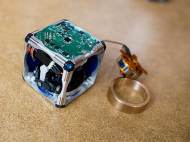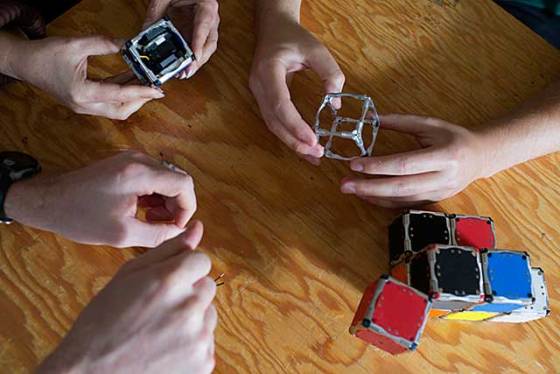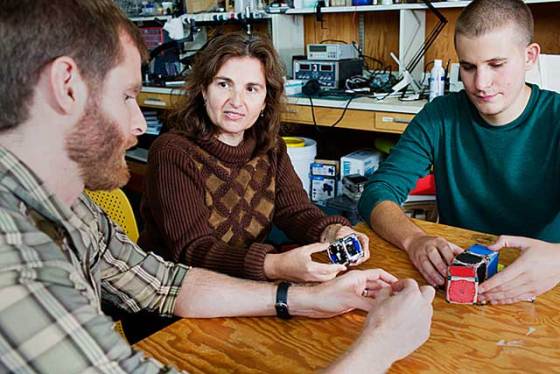M-Blocks – simple modules for self-assembling robots
 Despite the fact they are small cubes with no exterior moving parts, M-Blocks robots can propel themselves forward, jump on top of each other, and snap together to form more complex shapes. What makes them different from other examples of modular robotic cubes we previously wrote about is their simplicity because MIT researchers decided to abandon the principle of static stability when they designed them.
Despite the fact they are small cubes with no exterior moving parts, M-Blocks robots can propel themselves forward, jump on top of each other, and snap together to form more complex shapes. What makes them different from other examples of modular robotic cubes we previously wrote about is their simplicity because MIT researchers decided to abandon the principle of static stability when they designed them.
“It’s one of these things that the [modular-robotics] community has been trying to do for a long time”, said Daniela Rus, a professor of electrical engineering and computer science and director of Computer Science and Artificial Intelligence Lab (CSAIL). “We just needed a creative insight and somebody who was passionate enough to keep coming at it – despite being discouraged.”
Researchers studying reconfigurable robots have been relying on an abstraction called the sliding-cube model. In sliding-cube model, if two cubes are face to face, one of them can slide up the side of the other and, without changing orientation, slide across its top. Other currently existing modular-robot systems are also statically stable, meaning that their correlation stays the same when you stop their motion.
To compensate for its static instability, each edge of an M-Blocks robotic cube has two cylindrical magnets, mounted like rolling pins. When two cubes approach each other, the magnets naturally rotate, making the cubes attach each other no matter which side they are facing. The scenario works perfectly for smaller number of cubes, but it could represent a problem in larger clumps of cubes and I’ll return to that fact in the conclusion.
The edges of M-Blocks are also beveled, so when two cubes are face to face, there’s a slight gap between their magnets. When one cube begins to flip on top of another, the bevels, and thus the magnets, touch. The connection between the cubes becomes much stronger, anchoring the pivot.
On each face of a cube are four more pairs of smaller magnets, arranged symmetrically, which help snap a moving cube into place when it lands on top of another. Inside each M-Block is a flywheel that can reach speeds of 20,000 revolutions per minute. When the flywheel is stopped, it translates its angular momentum to the cube.
These features enable M-Blocks to climb over and around one another, leap through the air, roll across the ground, and even move while suspended upside down from metallic surfaces. The researchers plan to develop special-purpose cubes which could be equipped with cameras, lights, battery packs, or other equipment, which the mobile cubes could transport.
The general idea for use of these robots is in their numbers and modularity. Even if they fall apart or run into some obstacle, they could reassemble or rearrange themselves to adapt to the problem solution. In ongoing work, the MIT researchers are building 100 M-Blocks, each of which can move in any direction, and designing algorithms to guide them.
The researchers envision large groups of mobile cubes that could temporarily repair bridges or buildings during emergencies, raise and reconfigure scaffolding for building projects, or even take shape of furniture or tools that are needed. And they could swarm into environments hostile or inaccessible to humans, diagnose problems, and reorganize themselves to provide solutions.
Although the simplicity of the cubes’ design makes miniaturization promising, the fact researchers opted for permanent magnets instead electro-permanent magnets could lead to problems in re-arranging, re-assembling or even movement in larger groups of these robots. Use of electro-permanent magnets (electromagnet and a permanent magnet) allows the control of magnetization in the permanent magnet, or turning the magnet on or off without continuous supply of electrical energy.











Leave your response!